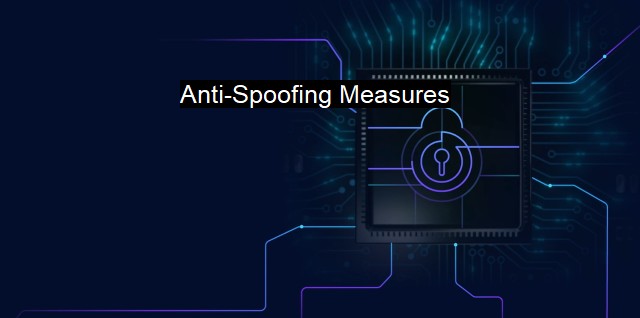What are Anti-Spoofing Measures?
Protecting Digital Identity: The Importance of Anti-Spoofing Measures in Cybersecurity
Anti-spoofing measures are fundamental aspects of cybersecurity which aim to prevent cunning subterfuges known as "spoofing" from causing harm to a system's security. Spoofing, by definition, is the act of masquerading as someone or something else, typically with intentions of launching attacks on a user's personal information or cyber system.To understand the concept of spoofing, imagine an imposter pretending to be your bank, emailing you about an account breach, urging you to sign in using the embedded link in the email. If you follow the instructions, the intruder--hiding behind the spoofed identity—would gain access to your banking secrets. As such, you become the target of spoofing—whether it is through email (email spoofing), Internet Protocol (IP spoofing), or Address Resolution Protocol (ARP spoofing).
Spoofing poses a significant threat to the cybersecurity realm, as the potential exploits it can create facilitate disastrous cyber attacks, such as Denial of Service (DoS) and Distributed Denial of Service (DDoS). Hence, security experts resort to anti-spoofing measures, which include various protocols, techniques, and software built to deter spoofing activities.
One of the significant anti-spoofing measures used against IP spoofing is ingress filtering. This protocol verifies the IP address of the packet leaving the network, comparing it with a cesarean of reachable IP addresses. If the incoming IP does not match, ingress filtering acts as a shield and blocks the packet.
Unicast Reverse Path Forwarding (uRPF) checks the source address on IP packets to ensure that they are reachable through the routing table. If a return path does not exist, it considers the source address spoofed and rejects the packet. Acknowledging the fallibility of single-layered protection, some networks integrate both methods to boost their anti-spoofing measures.
DNS (Domain Name System) spoofing, which tricks the system into believing it's interacting with a safe domain while it's connecting to an attacker's machine in reality, has its unique counter-measures. DNS Security Extensions (DNSSEC) use encryption to rectify the security loopholes present in the DNS, ensuring that the sites addresses are being sourced from legitimate locations. By means of validation and added security, DNSSEC ascertains the data's authenticity, thereby improving system security.
In terms of ARP spoofing, where the attacker intercepts connection between two systems to steal or alter data, Static ARP—an anti-spoofing measure—comes into play. By entering ARP entries manually into the cache, as opposed to the automated ARP entries, it significantly diminishes the likelihood of fraudulent entries and manipulations.
Anti-spoofing is also part and parcel of antivirus in order to fend off spoofed emails bearing harmful attachments or malware-infected links. Modern antivirus softwares can identify notable red flags such as misspellings, unprofessional grammar, and emblematic patterns, eliminating them before they cause harm.
In this advancing digital era, vicious spoofing techniques continue to evolve, rendering the necessity of anti-spoofing measures more critical than ever. Building strong authentication processes, investing in sturdy firewall systems, and garnering awareness about potential spoofing signals play crucial roles in equipping oneself against these illicit cyber activities. It's all part of navigating our progressively interconnected world while keeping our data safe and fortified.

Anti-Spoofing Measures FAQs
What is anti-spoofing?
Anti-spoofing refers to the measures taken to prevent cyber attackers from forging the source of an email or other communication to make it appear as if it comes from a trusted source.How does anti-spoofing work in antivirus software?
In antivirus software, anti-spoofing works by examining the header information of incoming email messages and comparing it to known patterns of legitimate messages. If there are inconsistencies, the software may flag the message as potentially fraudulent and either block it or move it to a separate quarantine area for further analysis.What are some common anti-spoofing techniques?
Some common anti-spoofing techniques include Sender Policy Framework (SPF), DomainKeys Identified Mail (DKIM), and Domain-based Message Authentication, Reporting and Conformance (DMARC). These measures verify that the sender of a message is authorized to use a particular domain name and can help prevent phishing and other types of fraud.Why are anti-spoofing measures important for cybersecurity?
Anti-spoofing measures are important for cybersecurity because they help prevent cyber criminals from tricking users into divulging sensitive information or downloading malicious software. By verifying the authenticity of incoming messages and blocking fraudulent ones, anti-spoofing measures can help keep networks and systems safe from cyber attacks.| | A | | | B | | | C | | | D | | | E | | | F | | | G | | | H | | | I | | | J | | | K | | | L | | | M | |
| | N | | | O | | | P | | | Q | | | R | | | S | | | T | | | U | | | V | | | W | | | X | | | Y | | | Z | |
| | 1 | | | 2 | | | 3 | | | 4 | | | 7 | | | 8 | | |||||||